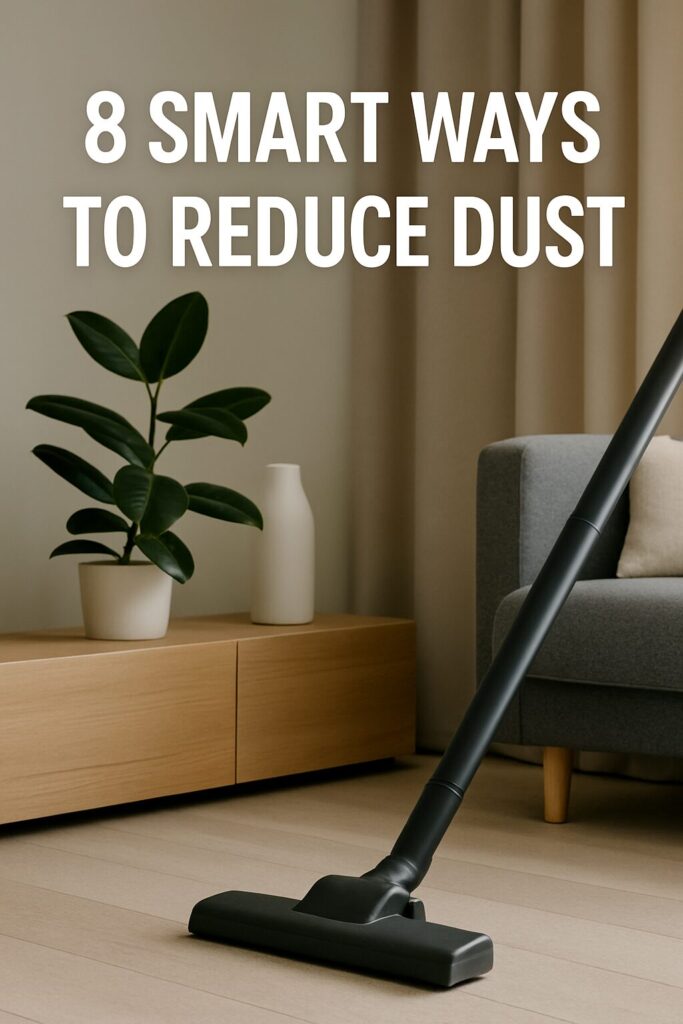
Want to reduce dust in your home? This practical guide shows you how to cut down allergens, pet dander, and fine particles with simple changes that actually stick. From better filters to smarter cleaning routines, you’ll learn how to reduce dust in your home without spending a fortune or cleaning nonstop.
Quick Answer (in 3 lines)
- Trap dust at the source with entry mats, closed shoes indoors, and frequent bedding/cloth washing.
- Improve filtration: MERV-rated HVAC filters, a HEPA vacuum, and (optionally) a room air purifier.
- Adopt a weekly routine—top-to-bottom dusting, then vacuum, then damp-mop—to keep buildup low.
Why Dust Builds Up (and How to Beat It)
Indoor dust comes from fabric fibers, skin cells, pollen, outdoor soil, pet dander, and combustion particles. It settles fastest on flat surfaces and soft furnishings. To reduce dust in your home, combine source control (less dust coming in), filtration (capture what’s airborne), and smart cleaning (remove before it resettles).
8 Smart Ways to Reduce Dust in Your Home
1) Stop Dust at the Door
Place sturdy doormats outside and washable rugs inside every entry. Adopt a shoes-off policy to keep grit, soil, and pollen out. This first barrier can dramatically reduce dust in your home with almost no ongoing effort.
2) Upgrade Your HVAC Filter (MERV Matters)
Use a high-quality pleated filter with a MERV rating appropriate for your system (often MERV 10–13 for many residential units). Change it every 1–3 months, more often with pets or construction nearby. Better filtration helps reduce dust in your home by trapping fine particles before they recirculate.
3) Vacuum with a Sealed HEPA Machine
A vacuum with a sealed HEPA system prevents fine dust from blowing back out. Vacuum high-traffic areas 2–3 times per week, and use the upholstery tool on sofas, curtains, and mattresses monthly. This routine will measurably reduce dust in your home, especially if you have pets.
4) Dust Top-to-Bottom (Then Damp-Mop)
Use a slightly damp microfiber cloth for shelves, frames, vents, and baseboards. Work high to low so falling dust is collected later by the vacuum. Finish with a damp mop on hard floors. This order is key if you want to reduce dust in your home efficiently.
5) Wash Fabrics on a Schedule
Bedding weekly (hot water if possible), pillow protectors monthly, curtains quarterly, and removable sofa covers per label. Frequent laundering removes trapped dander and fibers that otherwise shed into the air. It’s one of the easiest ways to reduce dust in your home long-term.
6) Declutter Flat Surfaces
Fewer knick-knacks mean fewer dust magnets. Group decor on trays and store rarely used items in closed cabinets. Minimal surfaces are faster to wipe and noticeably reduce dust in your home with less effort.
7) Consider a Room Air Purifier (HEPA)
In bedrooms or living rooms, a correctly sized HEPA purifier can capture fine particles between cleanings. Look for a CADR appropriate for your room size. Running it on low continuously can quietly reduce dust in your home and improve allergy comfort.
8) Control Humidity (40–50%)
Keep indoor relative humidity around 40–50% to help particles settle and to prevent static that keeps dust aloft. Use exhaust fans in kitchens and baths, fix leaks promptly, and consider a dehumidifier if needed. Balanced humidity will help reduce dust in your home and protect furnishings.
Weekly “Quick Clean” Routine (30–45 minutes)
- Step 1: Tidy and declutter surfaces (5–10 min).
- Step 2: Microfiber dust high → low (10–15 min).
- Step 3: Vacuum floors and upholstery (10–15 min).
- Step 4: Damp-mop hard floors (5–10 min).
Consistency beats intensity. A short, reliable routine will steadily reduce dust in your home more than occasional deep cleans.
Pet & Allergy Tips
- Brush pets outdoors and wash pet bedding weekly.
- Use mattress and pillow encasements to trap allergens.
- Keep bedroom doors closed during the day to reduce dust in your home where you sleep.
FAQ
Do air purifiers really help?
Yes—if sized correctly and using true HEPA filters. They capture fine particles between cleanings and can noticeably reduce dust in your home, especially in bedrooms.
What’s the best duster?
A slightly damp microfiber cloth outperforms feather dusters, which often just redistribute particles. Microfiber traps dust, helping you reduce dust in your home instead of moving it around.
How often should I change HVAC filters?
Every 1–3 months for most homes; monthly if you have pets, allergies, or ongoing construction dust. Regular changes are essential to reduce dust in your home via filtration.
Is carpet or hard flooring better for dust?
Hard flooring is easier to clean thoroughly, but well-maintained carpet combined with a sealed HEPA vacuum can still help reduce dust in your home. The key is frequent, thorough cleaning.
Helpful Resources
- EPA: Indoor Air Quality Basics
- ASHRAE: Filtration & Air Cleaning
- CDC/NIOSH: Indoor Environmental Quality
Explore More on AnswerNimbus
Want practical tips beyond dusting? Browse Home & Life for smart routines, organization ideas, and simple changes that reduce dust in your home while making life easier.
AnswerNimbus is an online knowledge hub providing step-by-step guides, how-to fixes, and clear explanations across technology, home, collectibles, and everyday curiosities. Our mission is to make useful information easy to find, understand, and apply.
